Test Answers on Nuclear Chemistry – Flashcards
Unlock all answers in this set
Unlock answersquestion
Things to consider while studying this unit
answer
1) I give the simple definition at the top, usually followed by examples or explanations. I put more detail than usual because I'm not there to answer questions. I want you to have an explanation if you need one. 2) You may always use the periodic table to answer questions. About a quarter of my job is to to teach you how to use the periodic table as big cheat sheet.
question
Why in the world am I required to learn nuclear chemistry in an introductory chem class?
answer
1) The State of Louisiana requires it. Plus, radioactive compounds are among the most useful tools in science and medicine. A chemist who doesn't regularly use radioactivity in his/her research is about as common as an Amish TV repairman. 2) Intro nuclear chemistry is a lot of material, but the math isn't hard. Out once you set the problems up the math is literally on about a 3rd grade level. (Also, don't forget to make sure you know the simple equations on cards 38-42, which I left off the last test due to space concerns.)
question
alpha particle
answer
a helium nucleus that is emitted from a radioactive atom. Alpha particles are a form of radiation called (you guessed it) alpha radiation.
question
beta particle
answer
an electron that is emitted from a radioactive atom. Beta particles are a form of radiation called beta radiation.
question
gamma particle
answer
a high-energy photon (particle of light) that is emitted from a radioactive nucleus. Gamma particles have zero mass and so do not affect the math in the word problems in this unit. Since light can have either wavelike or particle-like properties, you will often see this written as "gamma ray" rather than "gamma particle."
question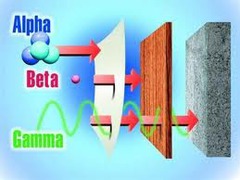
Arrange alpha, beta, and gamma particles in order of increasing ability to penetrate matter.

answer
alpha < beta< gamma. (Alpha can't go through paper. Beta can go through paper but not plywood. Gamma can go through moderately-thick layers of lead, but is stopped by thick layers of lead.)
question
How much more mass does a proton contain compared to an electron?

answer
A proton is a little over 1800 times as massive as an electron. Here is an example I came up with that might be useful: This is roughly the difference in mass between an adult human and 53 full-grown Asian elephants.
question
nuclear radiation
answer
the emission of alpha particles, beta particles, or gamma rays from the nucleus of an atom
question
mass number
answer
the number of protons and neutrons in the nucleus of an atom
question
atomic number
answer
the number of protons in the nucleus of an atom. The number of protons is unique to each element and defines that element. Example: there is one and only one element in the whole universe with 6 protons, and that atom is carbon.
question
isotope
answer
atoms that have the same number of protons (and are therefore the same element) but different numbers of neutrons. Isotopes are chemically identical, but some may be radioactive while others are not.
question
radioisotope
answer
an isotope that emits alpha particles, beta particles, and/or gamma rays.
question
stable isotope
answer
an "ordinary" element: an isotope that does not break down and does not emit particles or rays. Stable isotopes are the eventual breakdown products of radioisotopes.
question
atomic mass unit
answer
also called an amu. Equal to 1/12 the mass of a carbon-12 nucleus. This is approximately equal to the mass of a proton or a neutron, but since protons and neutrons have slightly different mass, an amu is defined as this particular fraction.
question
atomic mass
answer
All elements have several isotopes that exist in nature. Atomic mass is the weighted average of all the isotopes of an element.(Be careful not to get this mixed up with mass number, which is the total number of protons and neutrons in a given atom.)
question
positron
answer
a form of antimatter that is the opposite of an electron. Has exactly the same mass, but has a positive charge instead of a negative charge.
question
strong nuclear force
answer
the strongest of the four fundamental forces in nature. It only acts at very, very close range (on the size scale of an atomic nucleus) and holds the nucleus together. The attraction of the strong nuclear force is what keeps the nucleus from flying apart. Otherwise, the positive charges of the protons would repel each other when crammed so close together in the nucleus.
question
Which of the five senses can detect radioactivity?
answer
None of them. Although the slang term for a highly radioactive area or sample is "hot," radioactivity cannot be felt, seen, or otherwise sensed without the use of radiation-detecting instruments.
question
Scintillation counter
answer
A benchtop device used to detect radioactivity in chemical samples
question
film badge
answer
A plastic device that has unexposed film inside. It is worn on the clothing and used to monitor the exposure to radioactivity over a period of weeks. Film darkens if it is exposed to radioactivity, and this can be used gauge radiation exposure.
question
Geiger counter
answer
a handheld device used to detect radioactivity. Almost always used for safety purposes instead of measuring radioactivity in samples.
question
Radioactive tracer
answer
A radioactive compound used to trace where an element goes, often in a living animal. Examples: A) The carbon-14 in radioactive CO2 taken up by plants can later be detected as radioactive carbon in sugar, showing that the carbon in CO2 has been converted to the carbon in sugar as a result of photosynthesis. B) Radioactive iodine is injected to diagnose thyroid problems. If the radioactivity is later detected in the thyroid gland, the thyroid is taking up iodine.
question
How does radiation kill cells?
answer
Radiation forms ions in cells, which knock electrons off atoms. This weakens large molecules such as DNA, RNA, and proteins and causes them to break or become tangled and nonfunctional.
question
What type of cells does radiation preferentially kill?
answer
Radiation preferentially kills rapidly-dividing cells, since their DNA constantly doubling and RNA and protein levels are high, providing more targets for radiation damage. This is why radiation sometimes used to treat cancer. Normal cells are also damaged, but cancer cells are damaged more.
question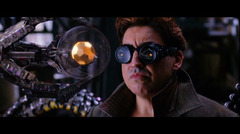
what is tritium?

answer
a radioactive isotope (radioisotope) of hydrogen that is commonly used in research. (Sorry, it has nothing to do with the mystery substance in the movie Spiderman 2.)
question
Based on your knowledge and on the symbol for tritium, how many protons does tritium have? How many neutrons?
answer
Tritium has 1 proton (the number on the bottom, aka the atomic number) and 2 neutrons (the number on the top, the mass number, is protons + neutrons, so the total number of neutrons is 3 - 1 = 2).
question
Based on your knowledge and on the symbol for carbon-14, how many protons does carbon-14 have? How many neutrons?
answer
Carbon-14 has 6 protons (the number on the bottom, aka the atomic number) as does every isotope of carbon. (6 protons is what makes it carbon) The number on the top, the mass number, is protons + neutrons, so 14 - 6 = 8 neutrons.
question
Using the periodic table and your knowledge of nuclear chemistry symbols, show where the mass number is in the symbol for uranium-235. (Sometimes abbreviated as U-235)
answer
(Remember that the mass number is the total number of protons and neutrons)
question
Using the periodic table and your knowledge of nuclear chemistry symbols, show where the atomic number is in the symbol for uranium-235.
answer
(Remember that the atomic number is the total number of protons and defines the element. Because the symbol tells what the element is anyway, the mass number is sometimes omitted unless needed for calculations.)
question
transmutation
answer
a radioactive nucleus breaks down by emitting alpha or beta particles. The loss of these particles changes the number of protons, and therefore converts it into another element. It can also occur artificially when an atom is split or is bombarded with smaller particles.
question
Suppose David Duke's head has a volume of 3 liters (3 L). If the mass of his head is 34.02 kilograms (34.02 kg), what is the density of David Duke's head? (Just plug the numbers into the formula for density.)
answer
Density = mass/volume (D = m/v) so 34.04 kg / 3 L = 11.34 kg/L (same density as lead)
question
Justin Bieber has the bighead. If Justin Bieber's head has a mass of 5 kg and a density of 0.27 kg/L, what is the volume of Justin Bieber's head?
answer
Rearrange D = m/v to solve for v: V = m/D = 18.5 L (about the size of an average beach ball)
question
fission
answer
breaking a large nucleus into smaller nuclei. This is what releases the energy in nuclear reactors and atomic bombs.
question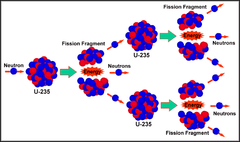
What subatomic particle sustains the nuclear chain reaction in nuclear reactors and atomic bombs?

answer
The neutron
question
fusion
answer
squashing smaller nuclei together to form larger nuclei. This releases even more energy than nuclear fission.
question
Which isotope of uranium is used to make nuclear reactors and atomic bombs?
answer
uranium-235
question
Uranium can be dug out of the ground and is the only thing that limits bad guys from making an atomic bomb. Why doesn't every terrorist and/or every Curly, Moe, and Larry on Earth have an atomic bomb?
answer
Only uranium-235 can be used to make bombs. Nearly all uranium on Earth is U-238 instead of U-235. Uranium-235 is only 0.7% of all uranium, and is chemically identical to U-238. It is very hard to separate. (You will have to know which isotope is which, but not the exact 0.7% figure.)
question
What is the most common nuclear reaction in the universe?
answer
The most common nuclear reaction in the universe is the fusion of hydrogen nuclei into helium-4. This is what causes stars to shine. It is also the reaction behind the energy release in hydrogen bombs. Fusion releases much more energy than fission, and there is no limit to the energy yield of a hydrogen bomb (e.g., it is entirely possible to make a hydrogen bomb big enough to knock the earth out of orbit.)
question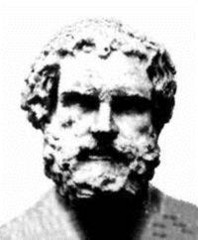
Who was the first person in recorded history to suggest the existence of atoms?

answer
Democritus. (Be sure not to mix him up with Archimedes the naked guy, who discovered how to find the volume of irregular solids.)
question
Describe Rutherford's gold foil experiment. At the time, how did scientists envision the distribution of positive and negative charges inside the atom? What did Rutherford expect for the results of this experiment?
answer
*Rutherford shot alpha particles into a thin piece of gold foil to study how these tiny positive charges interacted with the atoms in the gold foil. *At the time, it was thought that positive and negative charges were fairly evenly distributed throughout the atom, so he expected most of them to pass right through.
question
What were the surprising results of Rutherford's gold foil experiment? What did this imply about the structure of the atom?
answer
Most alpha particles passed straight through, but a very small fraction were bounced almost straight back as if the alpha particles had hit a very small, dense, positively charged object. This implied that (as the late Carl Sagan put it) "Atoms are mainly empty space. The universe is composed, chiefly, of nothing."
question
How were Dalton's ideas of the atom closer to being correct than those of Democritus?
answer
Among other things, Dalton suggested that atoms combine in fixed proportions. Today we know this to be true, hence 1 carbon and 2 oxygens make up carbon dioxide, 2 hydrogens and one oxygen make up water, etc.
question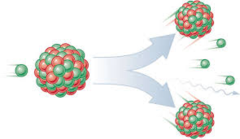
In what way is one part of Dalton's concept of the atom now known to be incorrect?

answer
We now know that atoms can break apart into smaller components.
question
Name one thing you can do change the rate of nuclear decay in a radioactive isotope.
answer
It's impossible to change the rate of nuclear decay in a radioactive isotope. The rate of radioactive decay is not changed by any factors that usually affect chemical reactions, such as adding or removing heat, raising or lowering pressure, etc.
question
If changes in heat, pressure, etc. don't affect nuclear decay rates like they do in chemical reactions, how are nuclear chain reaction rates controlled in a nuclear reactor?
answer
Neutrons are absorbed or slowed down by both graphite rods within the uranium of the reactor and water surrounding the uranium in the reactor. Since neutrons are what maintain a nuclear chain reaction, this slows down the spread of the chain reaction.
question
A beta particle is emitted from the nucleus. Where within the nucleus does it come from?
answer
A neutron breaks down into a proton and an electron. The proton stays put while the electron is kicked out of the nucleus as a beta particle.
question
What happens to the atomic number of an element when it undergoes beta decay? What does this do to the element? Why does this happen?
answer
*The atomic number goes up by one, which by definition means that it gains a proton and becomes a different element with a different atomic number. *A neutron in the nucleus decays into a proton and an electron, the latter of which is kicked out as a beta particle.
question
What happens to the mass number of an element when it undergoes beta decay? Why?
answer
Nothing. The mass number is the number of protons and neutrons. Since a neutron decays into a proton during beta decay, the decayed neutron is replaced by a proton. Therefore the mass number doesn't change because the total number of neutrons and protons stays the same. (If this isn't clear to you at first, see the examples in the following couple of cards.)
question
Write out the equation that represents carbon-14 undergoing beta decay. (As with any question you might be asked in chemistry from here on out, you may use the periodic table. You should be able to identify the reactant or product in any given nuclear reaction by making sure the superscripts and subscripts balance on each side of the equation.)
answer
Note that the superscripts and subscripts on the right total up to those on the left. The mass number doesn't change since beta decay is caused by a neutron breaking down into a proton.
question
Write out the equation that represents sulfur-35 undergoing beta decay.
answer
Again, note the superscripts and subscripts on each side of the equation total up to the same numbers.
question
Suppose a radioisotope is unstable due to an abundance of neutrons compared to protons. How does the atom naturally decrease the number of neutrons?
answer
Beta decay. Beta decay consists of a neutron breaking down into a proton and a beta particle, so beta decay decreases the number of neutrons and increases the number of protons.
question
Radioactive half-life (Note: this and the next two cards contain important "big picture" concepts. You'll want to make sure you understand these concepts in order to solve some of the math problems.)
answer
The radioactive half-life for a given radioisotope is the time for half the radioactive nuclei in any sample to undergo radioactive decay. For example, if a radioisotope has a half-life of 5 years, then 50% of it will be gone in 5 years, 50% of the remaining isotope will be gone 5 years after that (leaving a total of 25%), 12.5% will be left 5 years after that, 6.25% 5 years after that, etc. For time periods that do not conveniently fall exactly on a half-life, an equation involving logarithms is used, but that will not be covered in this unit.
question
Every living organism on Earth contains a small, consistent, predictable fraction of which radioactive isotope? This isotope is used to estimate the age of living things years after they die. What is this dating technique called?
answer
Carbon-14, which has a half-life of 5730 years. The technique of dating once-living objects with carbon-14 is called (surprise) carbon dating. (BTW, You don't have to remember the lengths of any half-lives. They will be given to you for any math problems on the test.)
question
Other than radioactive decay, how can an animal or plant lower its natural percentage of carbon-14?
answer
It can't. Carbon-14 levels in a living organism stay stable over its lifetime as long it is alive exchanging carbon with the environment (eating, breathing, pooping, whatever). After death, an animal or plant stops taking up and giving off carbon. After this the carbon-14 levels decay at a consistent known rate. We use this rate, expressed in half-lives, to calculate the age of a long-dead animal or plant.
question
The half-life of carbon-14 is 5730 years. Suppose a wooden cup is found in the Egyptian desert. The wood the cup is made of has 50% of the amount of carbon-14 that would be found in a living tree. How long ago was it that the tree this cup is made of was alive and exchanging carbon with the environment?
answer
5730 years x 1 half-life (time to decay to 50% of its original value) ~5730 years
question
The half-life of carbon-14 is 5730 years. Suppose a paleontologist finds a frozen wooly mammoth that has 25% of the carbon-14 that would be found in a living animal. How long ago was it that the mammoth was alive, exchanging carbon-14 with the environment?
answer
5730 years x 2 half-lives (time to decay to 25% of its original value) = roughly 17190 years
question
The half-life of tritium is 12 years. The level of radioactivity of a sample is often measured in disintegrations per minute (dpm). Suppose I accidentally spilled 800 dpm of tritium from a sample I'm working with onto the lab bench. How long before it goes down to a safer, near-background level of 50 dpm?
answer
800 dpm/2 = 400 dpm (1 half life) 400 dpm/2 = 200 dpm (2 half-lives) 200 dpm/2 = 100 dpm (3 half-lives) 100 dpm/2 = 50 dpm (4 half-lives) 4 half-lives x 12 years/half life = 48 years! (This is one of the many reasons scientists have to be very careful with radioactive samples.)
question
What is the answer to Life, the Universe, and Everything?
answer
42



